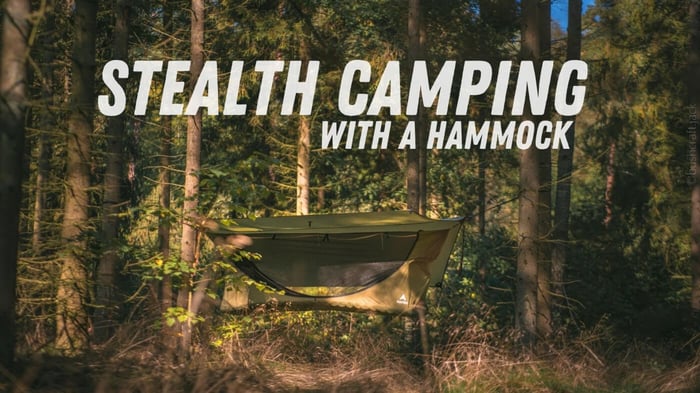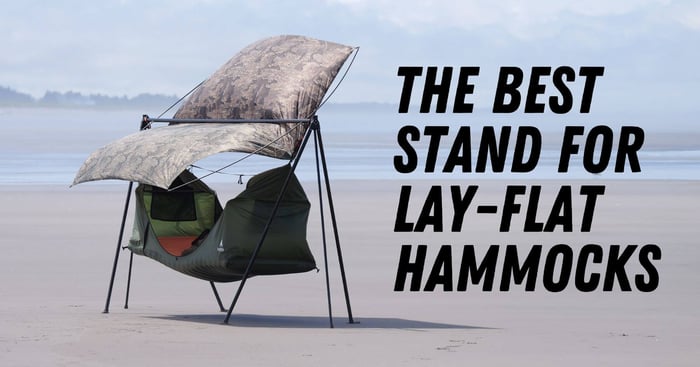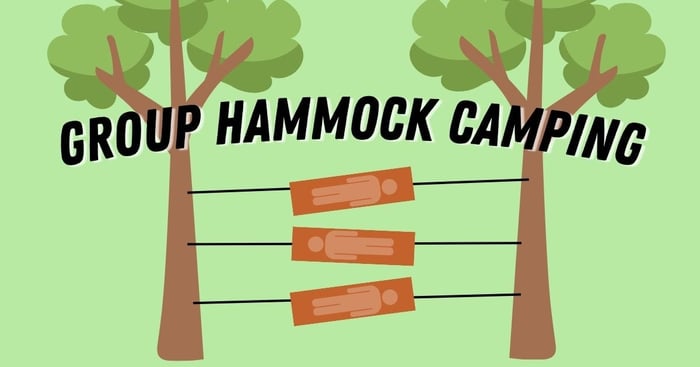Here's the inside scoop on sneeeaky camping, I mean stealth camping. Nothing is better than a relaxing night in the woods, and for those looking for the added thrill of flying under the radar or some extra spontaneity, stealth camping takes the camping experience to a whole new level. Unlike traditional camping, where the focus is often on designated sites and organized setups, stealth camping brings an element of secrecy and hopefully even more solitude to the outdoor experience.
Here we'll discuss the ins and outs of stealth camping along with why hammocks are PERFECT for your next clandestine outing.
What is Stealth Camping?
It seems like everywhere is getting more crowded. The roads, national parks, and of course the usual campsites. The spots I visited as a kid now have to be booked 9-months out.
With regular haunts becoming overrun, it makes sense that stealth camping is growing in popularity. Simply put, stealth camping is the art of camping discreetly, away from the confines of organized spaces. Often in unexpected, yet still legal zones. With stealth camping, you open up a world of privacy and even save some money on campsite fees.
This style of camping is particularly attractive to those who prefer spontaneity, as it eliminates the need for pre-booking official sites and allows travelers to immerse themselves in nature without the constraints of a predetermined location. Forrest Gump did it right, "When I got tired, I slept. When I got hungry, I ate. When I had to go, you know, I went."
First, it's important to understand the legal landscape. You'd hate for your fun camping adventure to end with a ticket for trespassing, or some angry farmer shining a light in your eyes at 3 a.m.
Is Stealth Camping Legal?
Well, that depends...The legality of stealth camping varies based on location and your own behavior while camping. Trespassing on private property, building fires, or altering vegetation can quickly draw attention and turn your little outing into an illegal activity.
Many cities and towns have regulations against overnight parking or camping. So before you lose internet service, research local laws and pick a few options along your route that look promising. Ask yourself, is this private property? And would anyone care if I was here?
GPS apps like ON X do a great job of identifying BLM, forest service, public, private, State, and National Park lands. Do your research but generally, the more remote you are the better! You're a lot more likely to get into trouble camping behind a Walmart than if you're off on a dirt track in the sticks.

Stealth Camping Pro Tips:
Last summer my cousins and I went to Alaska for a week of adventuring. We were backcountry for most of the nights but one night we had the option of grabbing a motel or finding a spot to stealth camp. We opted for another night in the woods 🌲😴🌲
We searched along our route for side roads that would have low traffic. Roads to nowhere. After scanning the map for a while we found a few candidate sites and before it got dark we pulled off the main road and into our stealth camping spot. We're not accustomed to camping so close to the car, but this made for an absolutely great night. We had the spot to ourselves and it didn't cost a dime.
For those intrigued by the idea of stealth camping, here are some essential tips to help you stay undetected:
1. Blend In with Nature:
When it comes to gear selection, prioritize natural and minimalist designs. Low visibility is the goal. Bright colors attract unwanted attention from passersby, drivers, or park rangers. Opt for shades and patterns that seamlessly blend with the surrounding foliage. Dark green, black, and gray are all great options. For those looking to take this to the next level, camouflage patterns take this one step further.
Once your palette is right, make sure you don't alter the foliage around your camp. This is your BEST cover and why we think hammocks are the best shelter options for stealth camping. With ground tents, you'll need to clear a site to set up. You move logs, uproot bushes, and stomp down grass. Creating an unnatural and quite obvious void in the wild area you're trying to hide in. Not very stealthy! On the other hand, a hammock gives you the ability to hang above and among your cover.
2. No Campfires or Lights:
While cracking campfires are a quintessential aspect of camping, they are a dead giveaway while stealth camping. Flames and smoky smells draw direct attention to your location. Haven't you ever watched a Western movie? Moreover, many rural areas prohibit fires, and being caught with one could result in fines or legal consequences.
Instead of relying on a campfire for warmth, pack some extra layers of clothing. Consider using hot water bottles or hand and foot warmers for added comfort during chilly evenings.
Along with the campfire, put out the light! The next biggest giveaway of a stealth camping location is a headlamp or flashlight. Now this is harder to do without. So try to limit use, use a light on low settings, or you can take a page out of the stealth tactics developed during the Vietnam War and cover your flashlight with a strip of tape. Put a little hole in the tape or pull up a corner to allow just a sliver of light out.
As Pappy always said, "A fire may warm you, but it also paints a target on your back. In these vast lands, shadows are your cloak, and silence is your friend. The wise man knows, in the wilderness, the less light, the more life."
3. Stay Quiet:
Along with camp colors, campfires, and artificial light, reducing noise is crucial for a successful stealth camping trip. Here are some tips for maintaining minimal noise levels:
- Go Solo: If possible (AND SAFE), embark on stealth camping trips alone. This eliminates the need for loud conversations, giving you total control over your noise levels. Unfortunately, solo camping increases the danger factors exponentially, so be smart and know your limits
- Arrive Just Before Dark: Limit your time at the campsite by arriving just before dark. This minimizes opportunities for detection, and you can use the cover of darkness to set up camp quietly.
- Use Earbuds: If you plan to listen to music, audiobooks, or podcasts, use earbuds or headphones to avoid creating noise that could attract attention.
Remember noise can really travel at night. A stick breaking or a phone dinging can blow perfectly good stealth camping cover.
4. Location Location Location:
Selecting remote sites away from busy roads, neighborhoods, major trails, and campgrounds is essential for minimizing the risk of discovery. The more out of the way you go, the less likely you are to be disturbed.
Foliage is your friend in stealth camping. While backcountry camping, I generally look for a nice meadow or creek to camp by. The perfect stealth camping site is a dense overgrown spot with natural terrain blocks. The good book says "A city that is set on a hill cannot be hid" so you probably shouldn't try to stealth camp up there either.
5. Leave No Trace:
Maintaining a clean stealth camp is essential for staying undetected. Even small signs like a broken tree branch can signal your presence to others. Dispose of all trash properly, including wrappers, garbage bags, and food remnants. Clean the area meticulously, removing footprints, bike tracks, or any other traces of your arrival. Minimize your impact by using minimal resources during your trip, such as eating before arriving at the campsite to reduce waste.
This is especially important if you plan to reuse the stealth camping site either that next night or further down the road. Permanent signs of human habitation can quickly add up. Another feather in the hammock-campers cap. By not clearing a site for a ground camp, hammock camps are completely invisible after you depart. "I fear you are underestimating the sneakiness (of hammock camping), sir."
6. Safety Gear:
When you camp in an established site surrounded by other campers you can rely on others to help in case of an emergency. On the other hand, stealth camping is all about self-reliance. You're remote, you're unknown, and probably alone... so bring this gear along.
- First Aid Kit: Remember if you didn't bring it, you won't have it.
- Extra Water: Stay hydrated by packing extra water, especially in remote areas. Proper hydration is crucial for maintaining energy levels.
- Extra Food: Boost your energy with additional snacks and food. Dispose of all trash properly after your trip.
- Map or Navigation Tool: If venturing into remote areas, use a map to avoid getting lost. Apps can also help identify public lands open for stealth camping.
- Personal Protection: Bear spray or pepper spray is a great option for personal protection while stealth camping. Firearms can increase the stakes if caught on private property or in case your site is investigated by law enforcement.
7. Let Someone Know:
A friend of mine stealth-camped his way across the US for about 6 months. It wasn't all stealth camping, but most nights he would just pull off when he got tired and find a place to stay. He was sharing his location with us the whole time so we could always see where he was (more or less) as long as he had service.
Prioritize safety by informing a trusted individual about your stealth camping plans and location. In case of emergencies, someone should know your whereabouts and how to reach you. This additional layer of security ensures that help can be summoned if needed.

Essential Gear Up for Stealth Camping:
The right gear makes for the best adventures. We already discussed colors that blend into your surroundings and the benefits of hammock camping over traditional tent camping. Hammocks tuck right into the best cover and leave little to no impact on vegetation. Hammock setup is quick and quiet, and in general, has a lower profile.
Aaaand while we have you looking at hammocks for stealth camping, you might as well get the best sleep of your life with our line of Haven Tent sleep systems. The most comfortable way to sleep outside. Each of these lay-flat sleep systems also has optional camouflage rainflies.
Earlier this year we looked at hundreds of camouflage patterns to find the perfect camo for stealth camping. A pattern adapted for the shadowed spots between trees. Our research brought us to the Realtree Timber pattern. We've licensed the pattern and now have it available for our most popular hammock tents.
Embark on your stealth camping journey with confidence, armed with the knowledge and gear to make your outdoor experience both thrilling and responsible. Sounds like you're doing something fun, we hope to join you!



